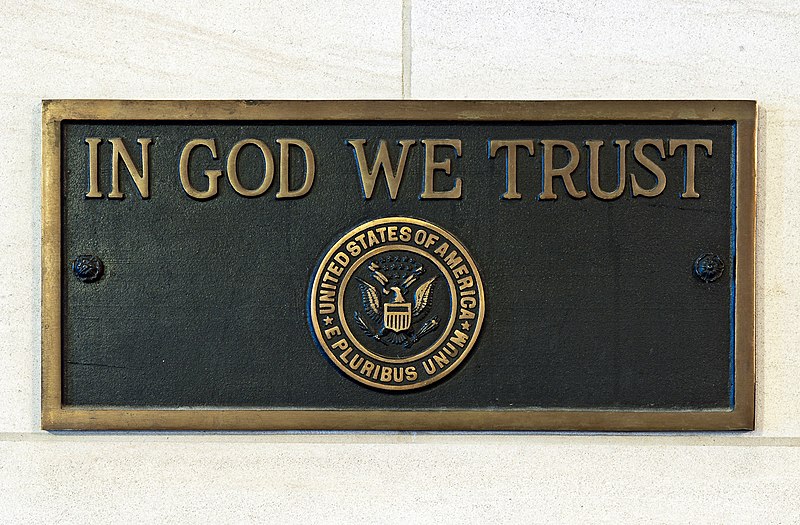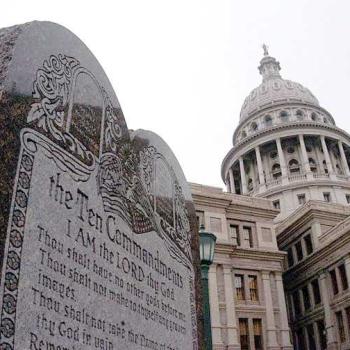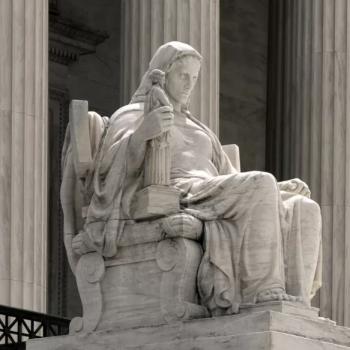A new law in Louisiana requires posting “In God We Trust” in every classroom in every school, from elementary to college, in the state. The law went into effect August 1, 2023. It replaces a previous law that mandated posting “In God We Trust” somewhere in every school building. The law provides that the motto “shall be displayed on a poster or framed document that is at least 11 inches by 14 inches. The motto shall be the central focus … and shall be printed in a large, easily readable font.” Further, teachers must instruct students about the phrase as a way of teaching “patriotic customs.”
Are we looking at another challenge to the Establishment Clause here? This Louisiana law is similar in some way to the Texas “Ten Commandments” bill I wrote about earlier this year; see “Do the Ten Commandments Belong in Public School Classrooms?” The Texas bill was very similar to a Kentucky law that the U.S. Supreme Court declared unconstitutional in 1980. The Texas bill failed to pass, but that was mostly because of a missed deadline. I expect Texas to try again.
The current Supreme Court has already done considerable damage to the wall of separation between church and state. (For more discussion of this see “Oklahoma Approves a Religious Charter School.”) People who want to use the public schools to indoctrinate children into conservative Christianity have been emboldened. And the Louisiana law has an extra complication for wall of separation supporters. “In God We Trust” really is an official national motto of the United States that appears on currency and other official government properties.
How “In God We Trust” Became a National Motto
The history of “In God We Trust” goes back to 1864, during the Civil War. The words first appeared on a two-cent coin in 1864. This was done at the urging of M.R. Watkinson, a Pennsylvania clergyman. Watkinson thought the placement would “place us openly under the divine protection” and help the Union win the war. The motto soon appeared on other coins, although late in the 19th century it was dropped off of most coins in favor of the older, unofficial national motto, “E pluribus unum” — out of many, one.
But “In God We Trust” was not forgotten. In the 1950s it was taken out of mothballs, so to speak. In the early 1950s “In God We Trust” began appearing on postage stamps. In 1955, President Dwight Eisenhower signed a bill that placed “In God We Trust” on all U.S. currency. In 1956 Congress passed a resolution making “In God We Trust” the official national motto. Note that the mid-1950s was the peak of anti-Communist hysteria in the U.S. I was a small child then, but I remember the late 1950s well enough. People were conflating Communism with atheism with Satan. Even my usually cheerful Lutheran Sunday School was showing us frightening pictures of Lucifer brandishing a hammer and cycle. There was much rallying around God in popular culture at the time. It was also in 1954 that the words “under God” were added to the Pledge of Allegiance. In Gallup surveys in the 1950s, over 90% of the adult population of the U.S. identified as Christian, Gallup says that’s down to 69 percent today.
A court challenge of “In God We Trust” on currency followed. In Aronow v. U.S. (1970) the Ninth Circuit Court of Appeals agreed with lower courts that the plaintiff, Stefan Ray Aronow, did not have standing to sue the goveerment about what was written on currency. But it set aside the standing issue to address the merits of the case. Use of “In God We Trust,” the opinion said, “is of patriotic or ceremonial character and bears no true resemblance to a governmental sponsorship of a religious exercise.” The Supreme Court declined to hear an appeal.
But What About School?
If it’s okay on coins, is it okay on the walls of a classroom? Going back to the appeals court ruling in Aronow, the opinion continued —
It is not easy to discern any religious significance attendant the payment of a bill with coin or currency on which has been imprinted ‘In God We Trust’ or the study of a government publication or document bearing that slogan. In fact, such secular uses of the motto was viewed as sacrilegious and irreverent by President Theodore Roosevelt. Yet Congress has directed such uses. While ‘ceremonial’ and ‘patriotic’ may not be particularly apt words to describe the category of the national motto, it is excluded from First Amendment significance because the motto has no theological or ritualistic impact. As stated by the Congressional report, it has ‘spiritual and psychological value’ and ‘inspirational quality.’
Most of us, God believers and not, use currency in our daily lives without feeling religiously compomised, I suspect. Although as a Buddhist I’d prefer “E pluribus unum” if anyone asks. But putting big signs saying “In God We Trust” in classrooms, and stipulating that teachers must instruct children about the phrase, seems to me to cross a line. This is not ceremonial or patriotic or mere inspiration. It is religion. A state government cannot require people to believe in God, but this is coming awfully close to doing that.














